Last Updated on November 3, 2023 by Matt Musico
There’s nothing quite like October baseball, right? The atmosphere just hits differently, especially if you’re fortunate enough to enjoy the playoffs in person. And when you watch a hitter slug a ball over the fence, it either gets everyone jacked up (if it happens in their home ballpark) or deflates an entire crowd (if it’s on the road). We’ve already covered which players have hit the most career postseason home runs, but which big leaguers have hit the most home runs in a postseason?
Want to see some homers in person this season? Of course you do. Grab tickets from our friends at TickPick. And before you get to the stadium, make sure you’re decked out in the right gear. Get your favorite team’s official merch from the MLB Shop or a ‘Big Dinger Energy’ shirt from our apparel store.
Most Home Runs in a Postseason
As it turns out, there are a lot of ties at the top of this particular leaderboard. Four different players have hit eight home runs in a postseason, while another five have hit seven home runs in a postseason. Only one dude has slugged more than that during a single trip to October, though, and we’ll start with him.
Randy Arozarena, 2020 Tampa Bay Rays: 10
Getting called up during a shortened season and participating in expanded playoffs led to one of my favorite stats from recent memory. Once 2020 was officially in the books, Randy Arozarena had clubbed eight career home runs in the regular season. In just one trip to the playoffs with the Rays, he was able to surpass that number.
It’s not like he was only hitting homers, though. Arozarena slashed .377/.442/.831 with 14 total extra-base hits (10 homers, three doubles, one triple), 14 RBI, and 19 runs scored, which sussed out to a 240 wRC+. He was an equal-opportunity performer, too — in each of the four rounds he and the Rays participated in, Arozarena never posted an OPS below 1.100.
With an October resume that already looks this stellar, it’s no surprise that the outfielder is currently the Rays’ career postseason home run leader.
Corey Seager, 2020 Los Angeles Dodgers: 8
Now, we turn briefly to the other side of the Rays’ 2020 World Series matchup to find Corey Seager, who went off for the Dodgers during the same postseason. However, while his overall performance was excellent, his power production was centralized to the NLCS and the Fall Classic.
Through Seager’s first 23 plate appearances, he produced just one home run and four RBI. Over his final 57 trips to the plate, he slugged seven dingers with 16 RBI. He produced a 1.230 OPS in the NLCS, followed by a 1.256 mark in the World Series. Seager ended up taking home a lot of hardware, too. He and Los Angeles not only captured the title they had been chasing for a while, but their shortstop won both NLCS and World Series MVP honors.
Nelson Cruz, 2011 Texas Rangers: 8
Nelson Cruz‘s 18 career October dingers are among the most postseason home runs in MLB history, and it’s because he took advantage of the Rangers‘ consecutive trips to the Fall Classic. The slugger collected 14 (!) of his 18 dingers during those two Octobers. The more fruitful trip obviously came in 2011 when he hit the most home runs in a postseason that year with eight.
When looking back on his stats, he mostly focused on generating a lot of power. He produced a 149 wRC+ with just a .226 batting average, with just more than half of his 14 total base hits landing over the wall. He had the benefit of opportunity between 2010 and 2011, playing in 33 postseason games. Cruz has appeared in just 17 playoff contests since, slugging four round-trippers.
It wasn’t just during the postseason where Cruz slugged lots of homers for the Rangers — he did it consistently in the regular season, too.
Carlos Beltrán, 2004 Houston Astros: 8
Carlos Beltrán debuted in 1998 with the Kansas City Royals. He didn’t get a chance to taste postseason action until he made it there with the Astros following a midseason trade in 2004. The outfielder was productive in 90 regular-season games following the swap (4.0 fWAR, 133 wRC+ with 23 homers, 53 RBI, 70 runs scored, and 28 stolen bases), but he just went off in October.
He needed just 12 games and 56 plate appearances to slash .435/.536/1.022 with eight home runs, 14 RBI, 21 runs scored, and six stolen bases for the Houston Astros, which led to a 284 wRC+. This was likely a big reason his seven-year, $119 million contract that offseason with the New York Mets was as high as it was.
The outfielder was a great player at all times, but his performance kicked up a notch in the postseason. Beltrán slashed .307/.412/.609 with 16 homers and 42 RBI in 256 playoff plate appearances. This also included a 14.5% walk rate and a 12.9% strikeout rate, all of which led to a 169 wRC+.
Barry Bonds, 2002 San Francisco Giants: 8
The Giants reached the postseason and made it all the way to the World Series while Barry Bonds was in the midst of one of the most dominant stretches ever. Just a year after breaking the single-season home run record, he produced his second straight year with a wRC+ of at least 230 and an fWAR of at least 12.0. His 2002 postseason performance stood as an outlier to the rest of his career, too.
Bonds reached the playoffs six other times with San Francisco and the Pittsburgh Pirates. Through all those trips, he produced a wRC+ above 80 just once and hit only one home run. In 2002, he slashed .356/.581/.978 with eight home runs, 16 RBI, and 18 runs scored, good for a 259 wRC+. His performance got better with each round, too. Here’s how his OPS looked from the NLDS through the World Series: 1.233, 1.318, 1.994.
San Francisco looked primed to make another deep run in October the following season after a 100-win campaign, but they were eliminated in the NLDS. In his last trip to the playoffs, Bonds posted a .889 OPS with no homers, and according to a number of factors, was on a pretty unlucky team, as determined by an exercise done by Bookies.com.
Be sure to also check out milestone Barry Bonds home runs through the years while you’re here.
Adolis Garcia, 2023 Texas Rangers: 8
An injury in the World Series cut Adolis Garcia‘s postseason short, but the 2023 ALCS MVP did plenty of damage before having to sit out Texas’ final two games before clinching a championship. This was Garcia’s first taste of playoff baseball, and he clearly relished the opportunity.
After hitting a career-high 39 homers during the regular season, El Bombi added another eight in the postseason. This also included a streak of five games in a row with a dinger. In addition to those eight taters, Garcia also added 22 RBI and 11 runs scored with a .323/.382/.726 line in 68 plate appearances.
Obviously, his favorite round of all was Texas’ ALCS showdown with the Houston Astros. En route to winning MVP honors, Garcia hit five homers with 15 RBI and a 1.293 OPS in 30 plate appearances.
Jose Altuve, 2017 Houston Astros: 7
Although Jose Altuve is turning just 32 years old in 2022, the Astros’ consistent and deep runs in the postseason already have him second on the all-time home run list. Not exiting October until at least getting to the ALCS for five straight years will help make that happen.
His first taste of postseason action in 2015 was rough, as he produced a -8 wRC+ through 27 plate appearances. That experience prepared him for Houston’s World Series run in 2017, hitting those seven dingers while slashing .310/.388/.634 with a 168 wRC+ in the process. Altuve hit just one homer the next postseason but has been consistent in 2019, 2020, and 2021 by hitting five home runs each year.
The ALDS has been his favorite round of play, evidenced by his career .324/.410/.667 line with 10 homers and 20 RBI through 117 plate appearances.
Daniel Murphy, 2015 New York Mets: 7
Between making his debut in 2008 and the 2014 season, Daniel Murphy built a reputation while with the Mets for being a solid hitter without a ton of power. After all, his single-season career-high mark for homers was 13 and he reached double digits just twice during this time. He eclipsed that number in 2015 with 14 dingers, but what happened that October took a lot of people by surprise.
His line through 64 postseason plate appearances was a Ruthian .328/.391/.724 with those seven home runs, 11 RBI, and 13 runs scored, all good for a 204 wRC+. What may be the most impressive part is who these homers came at the expense of. Guys like Clayton Kershaw, Zack Greinke, Jon Lester, and Jake Arrieta all gave up gopher balls to the infielder.
This spurred the most dominant two-year stretch of his MLB career, which came in 2016 and 2017 with the Washington Nationals. He won two Silver Slugger awards, finished second in NL MVP voting in 2016, and put together consecutive 20-homer campaigns. His performance over this time accounted for 10.0 fWAR, which was nearly half of his 23.5 career fWAR.
Jayson Werth, 2009 Phillies: 7
Jayson Werth is probably one of the few guys on this list I wasn’t expecting to see, but here we are. He participated in the postseason nine times during his MLB career and never hit more than two homers in a single trip…except for the 2009 playoffs with the Phillies. He hit at least two dingers in each round, and his production was on opposite ends of the spectrum. When he got a base hit, it was either a single or the ball sailed over the fence — there was nothing in between for the outfielder.
Power was just the theme of the 2009 season for Werth. He produced six years of 20-plus homers during his career, but his single-season best came in ’09 when he slugged 36 taters with 99 RBI, 98 runs scored, and 20 stolen bases. So, it makes sense that he just kept the power surge going deep into October as the Phillies attempted to defend their World Series title.
B.J. Upton, 2008 Tampa Bay Rays: 7
Sometimes, the postseason just brings out the best in certain players. That happened for B.J. Upton, as he and the Rays entered uncharted waters by playing October baseball for the first time. While he showed off his power potential in 2007 with 24 dingers, he hit just nine round-trippers in 640 plate appearances the following season. So naturally, Upton proceeded to slug seven homers in 72 postseason plate appearances that year.
All seven of his homers and 15 of his 16 total RBI came in the first two rounds, though. His OPS continually took a dive as Tampa Bay continued advancing. It went from 1.205 in the ALDS to a not-too-different 1.180 in the ALCS before dropping off a cliff to .500 in the World Series.
Upton made it back to the postseason four more times in his career, but he hit just one more home run. It came in 2016 with the Toronto Blue Jays.
Troy Glaus, 2002 Anaheim Angels: 7
Talk about capping off the most powerful three-year stretch of your career with a bang, right? After setting the Angels‘ single-season home run record in 2000 with 47 taters, Troy Glaus followed that up with 41 more homers in 2001 and 30 in 2002. He also drove in 100-plus runs during each of these campaigns. Glaus was essentially Bonds’ equal in the American League as both squads were on an eventual collision course to meet in the World Series.
The sweet-swinging right-handed hitter slashed an impressive .344/.420/.770 with those seven homers, 13 RBI, and 15 runs scored for the Angels. He saved his best work for the Fall Classic, as he produced a 1.313 OPS with six extra-base hits (three homers, three doubles) and eight RBI in 30 plate appearances en route to winning series MVP honors.
Want to see some homers in person this season? Of course you do. Grab MLB tickets from our friends at Vivid Seats. And before you get to the stadium, make sure you’re decked out in the right gear. Get your favorite team’s official merch from the MLB Shop or a ‘Big Dinger Energy’ shirt from our apparel store.
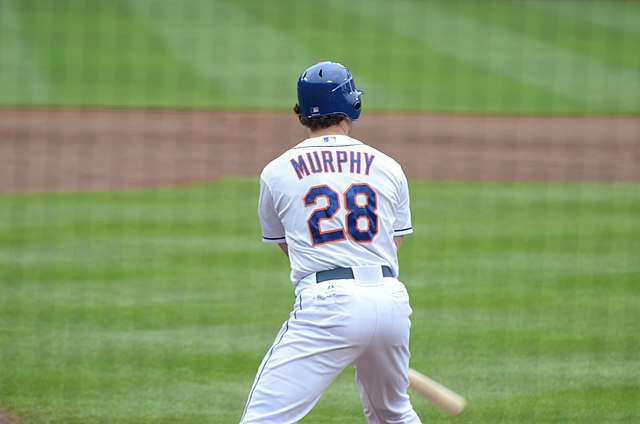
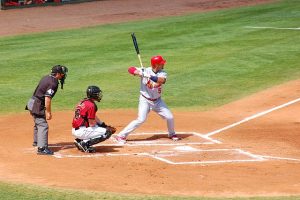
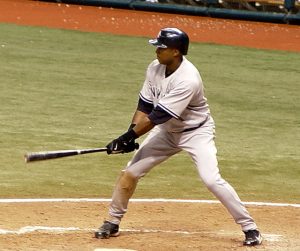
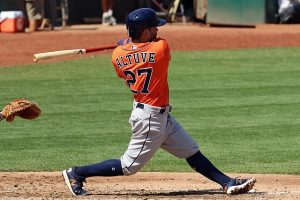
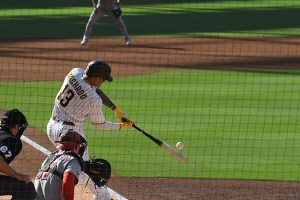
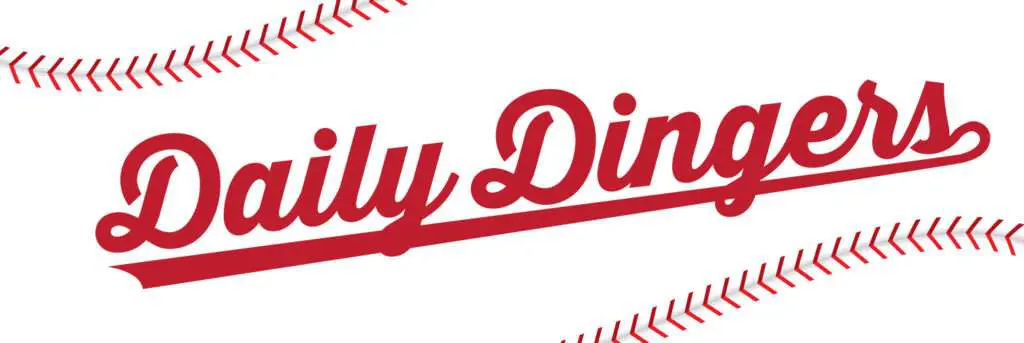
10 thoughts on “Most Home Runs in a Postseason: Top 11 Player Performances”
Comments are closed.